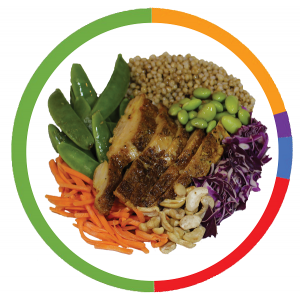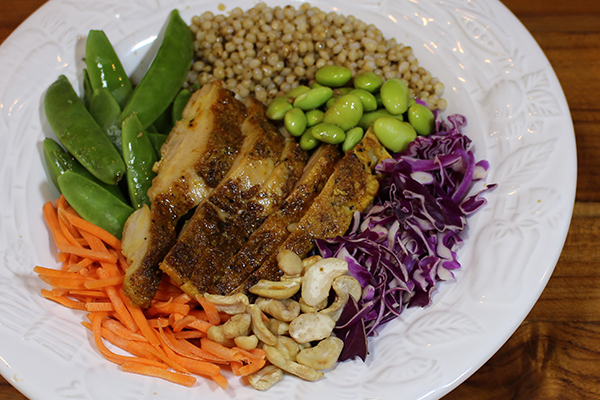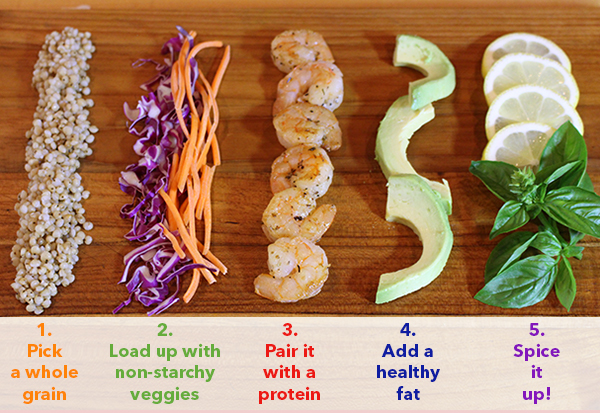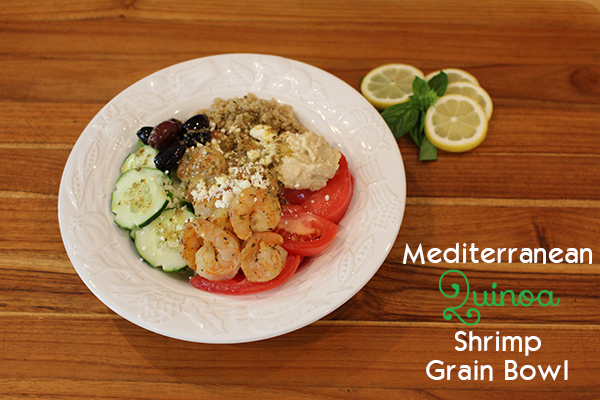Move over salad, grain bowls have entered the room! Google ‘grain bowls’ and you’ll have a whopping 21,900,000 search results at your fingertips. Popular food trend? I’d say yes, and for good reason! Grain bowls are extremely versatile, quick to prepare, super satisfying and nutrient dense. They encourage mixing and matching ingredients and allow you to create an array of textures and flavors through layering. And, come on, who doesn’t love eating an entire meal out of a bowl?!
Anatomy of a Grain Bowl
Constructed of grains, vegetables, protein and dressing, grain bowls can be served warm or at room temperature. You really don’t have to follow a recipe either, just throw together whatever ingredients you have on hand, and voila- a grain bowl! You can prepare them in advance for the week ahead or anytime you have a random collection of leftovers in the fridge.

While grain bowls sound like the perfect weeknight meal, be careful when choosing ingredients. Many grain bowl recipes are heavy on carbohydrates (beans, corn, and rice all in one bowl) and lacking in protein and vegetables. To ensure you get the proper quality and quantity of carbohydrates, protein and fat, build a better grain bowl by aiming for approximately:
- 20% whole, intact grains
- 50% non-starchy vegetables
- 20% protein
- 10% healthy fats
- Sprinkle of seasonings
Goodbye salad, hello #grainbowl! Learn how to build a better grain bowl with these simple tips. #saslife Click To Tweet
Build a Better Grain Bowl
There really isn’t a right or wrong way to assemble a grain bowl since it’s intended to encourage experimentation and creativity in the kitchen. Combine the flavors and textures YOU enjoy! But remember to pay attention to portions and choose high quality, minimally processed ingredients to ensure a nutrient dense, satisfying meal.
Print this handy GUIDE for ingredient inspiration and proper portions for building your grain bowl.
1. Pick a Whole Grain
Luckily, there are tons of options when it comes to grains since it’s just not a grain bowl without them! Be sure to opt for whole, intact grains as they are nutritionally superior to their refined, processed counterparts (i.e. brown rice versus white rice). Whole grains provide longer lasting energy and more stable blood sugar levels. Check out this guide to whole grains for more information.
Since whole grains are not as processed, they do take longer to cook. To save time during the week, prepare a large batch on the weekend to use throughout the week (you can also freeze extras!). Check out this great grains guide for details on how to prepare various whole grains.
Options include (but not limited to): sorghum, quinoa, wild rice, brown rice, barley, amaranth, millet, kamut, farro, teff, spelt berries, wheat berries, rye, etc. While not a grain, you could also include starchy vegetables like potatoes, winter squash or corn (they provide similar carbohydrate content as grains which is why you’d want to include them in this category).
2. Load up with Non-Starchy Vegetables
Aim for 50% of your bowl to be non-starchy vegetables. This is going to boost the nutrient content while ensuring you don’t go overboard with the carbs. Pick a variety of vegetables, both cooked and raw, to provide extra flavor, texture and color.
Options include (but not limited to): kale, spinach, asparagus, carrots, tomatoes, cucumber, peppers, broccoli, sugar snaps, cauliflower, green beans, Brussels sprouts, zucchini, squash, etc…basically anything except corn, peas, potatoes and winter squash (while not a grain, these would fall more in the ‘grain’ category due to their similar carbohydrate content).
3. Pair it With a Protein
A grain bowl wouldn’t be a complete meal without some protein! Protein is an essential part of every cell, tissue and organ in our bodies. It helps stabilize blood sugar levels and keeps us feeling fuller longer. Don’t skimp on the protein! Aim for about 20% (or 3-4 ounces) of protein in your grain bowl.
Use leftover protein from last night’s dinner or prepare a large batch on the weekend to use throughout the week. Choose one (or more) types of protein to include from animal and/or plant-based sources.
Options include (but not limited to): chicken, fish, shrimp, eggs, pork, beef, edamame, tofu, tempeh, lentils, beans, etc. Since lentils and beans also contain carbohydrates, when including them cut back on the portion of grains to help keep the optimal carbohydrate/protein ratio.
4. Add a Healthy Fat
Healthy fats provide long lasting energy, stabilize blood sugar levels and help your body absorb all the fantastic fat-soluble vitamins from the other ingredients in your grain bowl. Be mindful with portions as calories will add up quickly from this category, but don’t skip them! Avoid hydrogenated oils and pre-made dressings and dips that contain hydrogenated oils and added sugar.
Options include (but not limited to): nuts, seeds, avocado, tahini, hummus (fat content varies depending on recipe), olives, natural nut or seed butter without added sugar, etc.
5. Spice it Up!
Grains need a little moisture so finish the grain bowl off with sauce or dressing (preferably homemade) and other bits and bobs for pops of flavor and pizzazz.
Options include (but not limited to): fresh or dried herbs and spices, cheese, salsa, pesto, capers, fruit, olive oil-based homemade dressing, citrus juice and/or zest, etc.
We’ve provided two recipes below to inspire you to create your own grain bowl masterpieces. Now get in the kitchen and start having fun!
Stir-Fry Sorghum Chicken Grain Bowl
Makes 1 Serving
PRINT RECIPE
Ingredients
½ to 1 cup cooked sorghum
2-3 oz sugar snaps
½ cup shredded cabbage
½ cup shredded carrots
3 oz cooked chicken (for vegetarian/vegan, use tofu)
¼ cup edamame, cooked and shelled
Sprinkle of cashews
Soy Dressing
2 Tbsp low sodium soy sauce or tamari
1 clove garlic, minced
¼ tsp dried ground ginger
¼ tsp maple syrup
Splash of orange juice (optional)
¼ tsp ground black pepper
Directions
- Combine dressing ingredients and stir well in a small bowl. Set aside.
- Layer remaining ingredients in a bowl, starting with sorghum and then adding vegetables, chicken and edamame.
- Sprinkle with cashews.
- Drizzle soy dressing on top.
- Serve warm or at room temperature.
Mediterranean Quinoa Shrimp Grain Bowl
Makes 1 Serving
PRINT RECIPE
Ingredients
½ to 1 cup cooked quinoa
Salt, pepper and dried oregano, to taste
1 small cucumber, sliced
1 medium tomato, cut into wedges
3-4 oz shrimp
2 Tbsp hummus
1 Tbsp olives, sliced or whole
Sprinkle of feta cheese
Lemon Dressing
1 Tbsp olive oil
1 Tbsp lemon juice
½ tsp Dijon mustard
1 tsp dried oregano
Salt and pepper, to taste
Directions
- Combine dressing ingredients and stir well in a small bowl. Set aside.
- Toss shrimp with 1 Tbsp lemon dressing and place into a skillet over medium heat.
- Cook shrimp until bright pink and opaque, about 3-4 minutes. Set aside.
- Season cooked quinoa with salt, pepper and dried oregano, to taste.
- Layer ingredients in a bowl, starting with quinoa and then adding vegetables and cooked shrimp.
- Add hummus and olives and sprinkle with feta cheese.
- Drizzle remaining lemon dressing on top.
- Serve warm or at room temperature.





